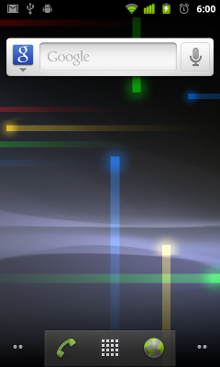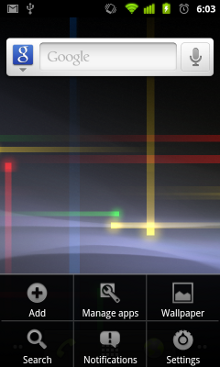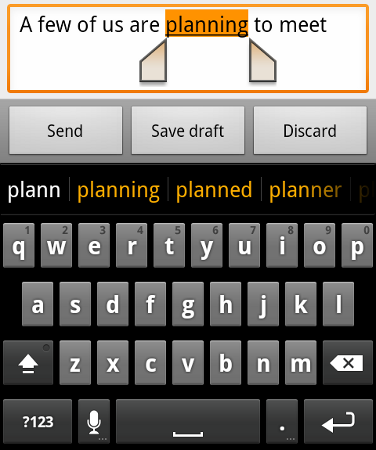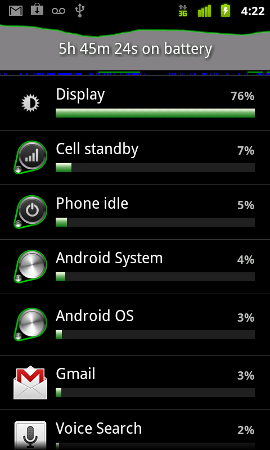Android 2.3 ships with gaming acceleration, media enhancements
Dec 6, 2010 — by Eric Brown — from the LinuxDevices Archive — 2 views[Updated, 1:00p.m.] — Google announced Android 2.3, touting a new user interface, support for front-facing cameras, and enhanced gaming performance. “Gingerbread” offers compatibility with Near Field Communication (NFC), SIP/VOIP, and the VP8 and WebM video formats, the company says.
The simultaneous release of Android 2.3 and the Nexus S follows a series of tips and leaks on both in recent weeks.
Android 2.3 may not be as significant an upgrade as last May's Adobe Flash-enabled Android 2.2 ("Froyo") release, and will not likely be as momentous as next year's Android 3.0, which is expected to make Android suitable for tablets. Yet, it pushes the open source mobile platform forward in a number of areas, including gaming, multimedia, and wireless e-commerce.
Running on Linux 2.6.35, Android 2.3 offers faster performance, says Google. Although there does not appear to be the sort of speed boost found in Froyo's web browsing, performance improvements have occurred in a number of areas such as garbage collection and event handling aimed particularly at improving game performance (see farther below).
In addition, the release offers a number of techie features aimed at developers, and Google has also updated the Android SDK Tools (r8), NDK, and ADT Plugin for Eclipse (8.0.0), as described farther below.

Google's Nexus S
As expected, the developer-focused phone offers a 1GHz Samsung Hummingbird processor, as well as a four-inch, 800 x 480 Super AMOLED display, and provides support for Gingerbread's NFC short-range wireless functionality. Other features include a five-megapixel back-facing camera and a front-facing VGA webcam. (For our separate, more extensive coverage of the device, go here.)
Android UI overhaul and text input changes
One of the most highly anticipated enhancements to Android 3.1 — the new user interface (UI) — is given relatively modest emphasis in Google's announcement. Gingerbread features a simplified visual theme with colors against a black background, as well as more green coloring worked into the design. The UI "brings vividness and contrast to the notification bar, menus, and other parts of the UI," says Google.


Android 2.3's UI overhaul
(Click on either to enlarge)
Such UI layers lead to fragmentation of the Android experience, many argue. Yet so far, manufacturers of UI layers such as Motorola's MotoBlur, HTC's Sense, Samsung's TouchWiz, and Vodafone's "360" have yet to say they would willingly remove their skins or make them optional.
Android's virtual keyboard has been enhanced with reshaped keys, improved positioning, and new input techniques, says Google (see image below). Users can correct entered words based on suggestions in the dictionary, says Google. A new "multitouch key-chording" feature, meanwhile lets users quickly enter numbers and symbols without needing to manually switch input modes, says the company.
Gingerbread is also said to offer a one-touch copy and paste feature. This lets users select a word on a web or text page using "press-hold," and then copy the text to the clipboard for pasting.

Android 2.3's virtual keyboard has been modified with new shapes and locations.
Gingerbread also offers improved power management, and it more actively monitors and controls apps running in the background, closing them if they are consuming too many CPU resources. Google doesn't call this a "task killer," a feature available with several third-party power management apps, but it appears to be similar.

Power management at a glance on Android 2.3
(Click to enlarge)
Support for SIP VoIP and multiple cameras
The other Android 2.3 features that will be most noticeable to the average Android user include native support for new communications features including SIP-based VoIP (Voice over IP), multiple cameras (i.e. front-facing camera support), and, as previously tipped, near field communication (NFC) short-range wireless technology.
The native support for the widely used SIP standard for VoIP means that SIP functions can be more easily be integrated into apps. In addition, users can now add a SIP address to any contact and can initiate a VoIP call from Quick Contact or Dialer, says Google. Users will still need to sign up for their own SIP account, however, says the company.


Gingerbread's SIP calling (left) and NFC tagging support (right)
For example, applications can quickly discover all the cameras on a device, as well as their types and characteristics, and then open the desired camera needed. For example, a video chat app could automatically access a front-facing camera, while a photo application could choose a higher resolution back-facing camera.
NFC comes to life
The Nexus S appears to be the first NFC-enabled Android phone, but with Gingerbread's support for the wireless "contactless" technology, many more phones are likely to offer the feature soon.
Android 2.3 lets users of NFC-enable Android phones touch or swipe an NFC tag that might be embedded in a poster, sticker, or advertisement, and then act on the data read from the tag, says Google. For example, after collecting a tag at a restaurant, store, or event, users might be able to rate or register the relevant product or service by jumping to a website via a URL embedded in the tag, says the company (see image above, at right).
Shortly after Google CEO Eric Schmidt tipped Android 2.3's NFC support last month — while also briefly flashing the NFC-enabled Nexus S — Verizon Wireless, AT&T, and T-Mobile announced a new"Isis" venture that will roll out a mobile commerce network based on smartphones embedded with NFC networking chips.
In addition to enhancing communications support, Gingerbread adds a Downloads app that gives users easy access to any file downloaded from the browser, email, or another application, says Google. The app is said to be built on a new download manager facility in the system that can be used by any Android app.
Game development boosted
One of Gingerbread's most significant enhancements will at first only be noticeable by app developers. Gaming is the main thrust here, with Android 2.3 adding a new concurrent garbage collector while also optimizing the platform's overall event handling. These features, as well as updated video drivers that improve the efficiency of OpenGL ES operations, are claimed to improve the performance of all applications, but are especially targeted at games and other 3D animated content.
Integrated in the Dalvik VM (virtual machine), the new, concurrent garbage collector minimizes application pauses, helping to ensure smoother animation and increased responsiveness, says Google. Android 2.3 also offers faster event distribution, more efficiently handling touch and keyboard events. At the same time, it is said to minimize CPU utilization during event distribution.
Developers of games and other apps can also call upon Android 2.3's capability to receive and process input and sensor events directly in native code, touted for improving performance. Apps can now enable and disable specific sensors, as well as manage event delivery rate and queueing, says the company.
In addition, Android 2.3 is said to add API support for new sensor types, including gyroscope, rotation vector, linear acceleration, gravity, and barometer sensors. The combined gyroscope and accelerometer support, for example, enables the development of apps that recognize complex user gestures and motions, such as tilt, spin, thrust, and slice, says Google.
Additional developer-oriented features in Android 2.3 include a software implementation of the new Khronos OpenSL ES audio API and Khronos EGL graphic interface. In addition, a new NativeActivity class offers lifecycle callbacks implemented directly in native code, says the company. Native APIs are also said to be exposed for managing windows, assets, and storage.
VP8, WebM, and other multimedia enhancements
As was tipped by Google shortly after Froyo's release, Android 2.3 offers support for the VP8 open video compression format and the related WebM open container format. The platform also adds support for AAC encoding and AMR wideband, software-based encoding, so that applications can capture higher quality audio than narrowband, says Google.
Sponsored by Google, WebM is an open source project developing a royalty-free WebM media file format designed for the web. Based on the Matroska media container, WebM works together with the VP8 video codec, as well as the Vorbis audio codec.
VP8 was acquired by Google when it picked up On2 Technologies in February. Designed to take advantage of HTML5, WebM and VP8 could compete with proprietary media playback technologies such as Flash, RealPlayer, and H.264.
Gingerbread's multimedia capabilities have also been boosted with a new media framework that fully replaces OpenCore, says Google. The framework is said to maintain all previous codec/container support for encoding and decoding.
Finally, a new audio effects API lets developers add equalization, bass boost, headphone virtualization (widened soundstage), and reverb to audio tracks and sounds, says Google. The API is said to enable the mixing of multiple audio effects in a local track or the application of effects globally across multiple tracks.
A new SDK
As noted, upgrades have been made to the Android software development kit (SDK) Tools (r8), as well as the Native-code Development Kit NDK, a companion tool to the Android SDK designed to "build performance-critical portions" of apps in native code. In addition, there is a new version 8.0.0 of the ADT Plugin for Eclipse (8.0.0).
Enhancements available in the development kits are said to include simplified debug builds, as well as integrated ProGuard support, touted for letting developers "obfuscate their code as an integrated part of a release build." In addition, the HierarchyViewer tool has been updated with a new UI, and is now accessible directly from the ADT Plugin, says Google.
Finally, Android 2.3's development kits are said to offer an early release of a new visual layout editor lets developers create layouts in ADT by dragging and dropping UI elements from contextual menus.
Android 2.3's official YouTube video tour
Source: Google
(Click to play)
Android 2.3 is available now to registered Android developers. The announcement may be found here, and a closer look at Android 2.3, as well as the newly updated Android SDK, NDK, and ADT Plugin for Eclipse may be found here.
This article was originally published on LinuxDevices.com and has been donated to the open source community by QuinStreet Inc. Please visit LinuxToday.com for up-to-date news and articles about Linux and open source.